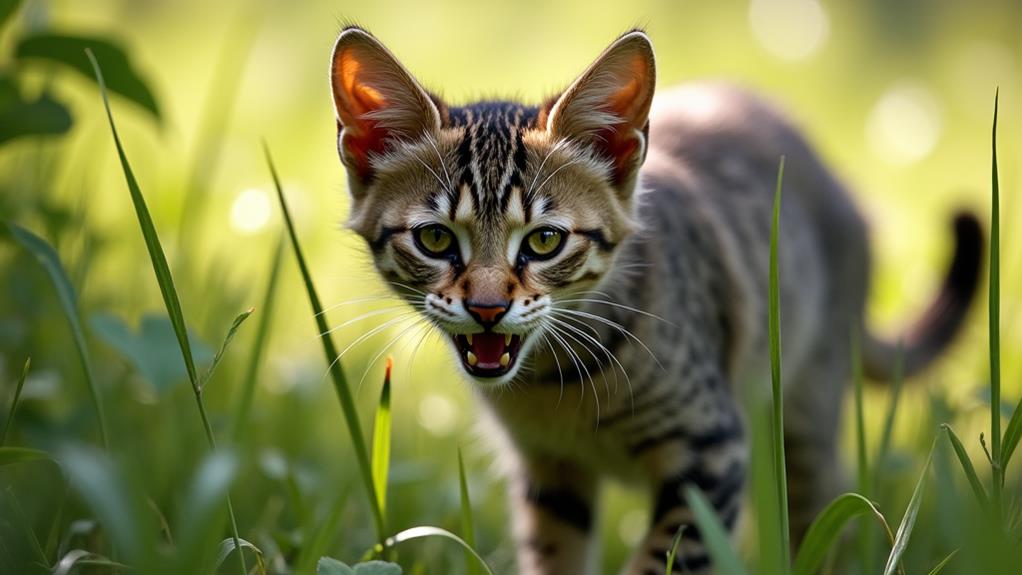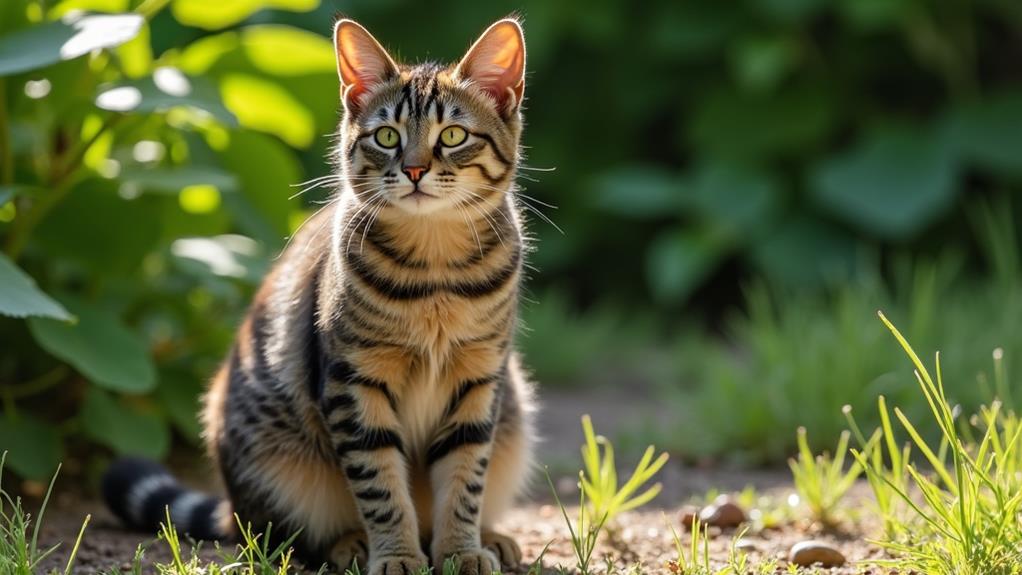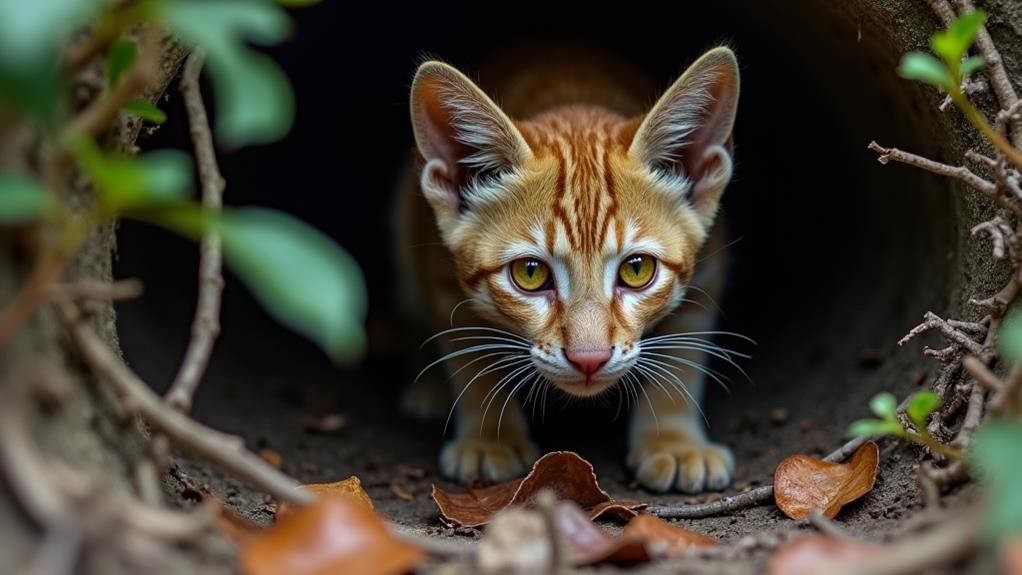How to Tell if a Cat Is Feral: Key Signs and Behavior Clues
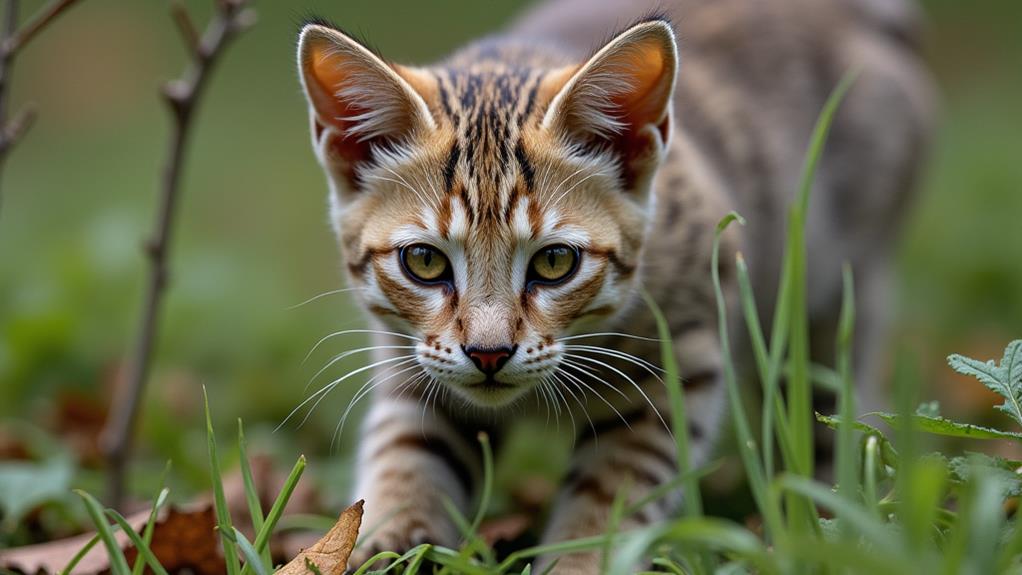
To determine if a cat is feral, watch for avoidance behaviors like hiding or fleeing when approached. Look for body language such as low posture, flattened ears, and a tucked tail, indicating fear or aggression. Feral cats often hiss, growl, or spit when threatened. They're primarily nocturnal, so increased nighttime activity could signal their presence. Check for signs of scruffy fur and a lean body, revealing difficulty finding food. Ear-tipping is also a clue, showing they've been through TNR programs. Spotting these traits can help distinguish feral from stray cats, and there's more to uncover about their behavior and needs.
Identifying Behavioral Patterns
When trying to determine if a cat is feral, pay close attention to its behavioral patterns. Feral cats are different from stray cats, mainly in how they interact with humans. You'll notice that feral cats generally exhibit strong avoidance behaviors. They tend to flee or hide when approached, clearly showcasing their fear of interaction. This contrasts with stray cats, who might be more accustomed to human presence, even if they're initially cautious.
Look at the cat's body language for more clues. A feral cat often displays a low posture, with its ears flattened against its head and its tail tucked. These signs indicate fear or aggression. If a cat hisses, growls, or spits when you get too close, it's likely feral. These defensive actions are natural responses when they feel threatened or cornered.
Feral cats are mainly nocturnal. They're more active at night when hunting for food, aligning with their survival instincts. This nocturnal behavior is another key difference from stray cats, who might search for food during the day. Understanding these behavioral patterns helps you distinguish between stray and feral cats effectively.
Understanding Physical Traits
While behavioral patterns offer insights into a cat's nature, physical traits can provide further evidence of if a cat is feral. Unlike domestic cats, feral and stray cats often bear signs of their harsh environment. Recognizing these traits is vital for animal welfare efforts, as it helps in identifying cats that may need assistance or inclusion in TNR programs. Here's how you can tell if a cat is feral based on its physical appearance:
- Coat Condition: Feral cats typically have scruffy, unkempt coats. Their fur might appear dirty or matted, a direct result of inadequate grooming and the absence of regular care.
- Body Condition: A lean and skinny body is another indicator. Feral cats often struggle to find food, which results in a less robust physique compared to well-fed domestic cats.
- Ear-Tipping: Look for a small, surgically removed portion of the ear. This ear-tipping symbolizes their participation in a TNR program, distinguishing them from other strays.
- Dental Health and Parasites: Poor dental health, such as worn or broken teeth, along with the presence of parasites like fleas or ticks, are common in feral cats. These issues highlight their ongoing health and hygiene struggles.
Understanding these traits aids in distinguishing feral from stray cats, facilitating better animal welfare practices.
Observing Nocturnal Habits

In the quiet of the night, feral cats come alive, exhibiting their natural instincts and behaviors. These nocturnal habits are vital for their survival, as they become most active during nighttime when the risk of human contact is minimized. Feral cats often hunt for food under the cover of darkness, with their activity peaking at dusk and dawn. During these hours, they rely on stealth and ambush tactics, fundamental elements of their instinctive hunting patterns.
Observing these cats at night can help you distinguish if a cat is stray or feral. A feral cat is likely to avoid daylight activity, steering clear of humans and the potential dangers associated with them. In contrast, stray cats might be more visible during the day as they seek out human interaction or assistance, often approaching homes or familiar areas for food.
If you notice an increase in cat activity in your area during nighttime hours, it's a good indication you might be dealing with feral cats. These nocturnal habits—avoiding daylight and minimizing human contact—are significant signs that differentiate feral cats from their stray counterparts, who might be more comfortable around people.
Approaching Feral Cats
Understanding nocturnal habits offers insight into a cat's feral nature, leading to the next vital step: how to safely approach these elusive creatures. Feral cats often exhibit avoidance behaviors, such as hiding or fleeing, indicating their lack of socialization with humans. When you're trying to get closer to a feral cat, approach slowly and cautiously. Sudden movements can trigger defensive reactions like hissing or growling. It's important to be aware of their body language.
Watch for these signs:
- Low Posture: A feral cat might crouch low to the ground, ready to bolt at any moment. This posture indicates fear and a readiness to escape rather than engage.
- Flattened Ears: If the cat's ears are pinned back, it's a clear sign they're feeling threatened and defensive.
- Tucked Tail: A tucked tail signifies anxiety and a desire to avoid confrontation.
- Avoidance Behaviors: Hiding or quickly retreating when you get too close shows they're not comfortable with human interaction.
Differentiating Stray From Feral
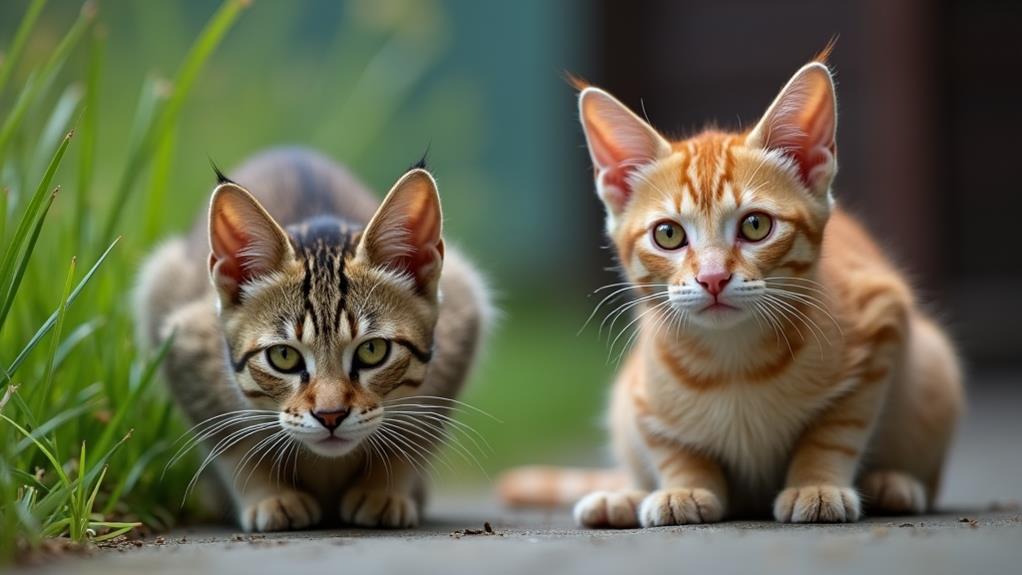
Identifying the difference between stray and feral cats hinges on their behavior towards humans. Stray cats typically show signs of previous human interaction, often approaching people for food and attention. They may be friendly or at least tolerant, and you might even find them rubbing against your legs or meowing for attention. In contrast, feral cats generally avoid human contact. They're more likely to flee or display fear and aggression when approached. This avoidance stems from their lack of socialization with humans, unlike domestic cats who have been socialized as pets.
When trying to differentiate, observe how a cat interacts with its surroundings. Strays are more approachable and can be checked for microchips, indicating a past as a domestic pet. They might be open to rehabilitation and may adapt back to indoor life with patience. On the other hand, feral cats are used to outdoor survival and require cautious observation. They exhibit defensive behaviors if they feel threatened. Remember, kittens born to strays without human contact likely become feral, underscoring the importance of early socialization. Recognizing these behaviors helps determine if the cat is a stray, feral, or potentially a lost domestic cat.
Utilizing TNR Programs
Recognizing if a cat is stray or feral can guide you towards the most appropriate course of action, such as participating in TNR programs. TNR, which stands for Trap-Neuter-Return, is a humane and effective method for managing feral cat populations. By trapping, neutering, and returning feral cats to their original locations, you help stabilize their colonies, reduce unwanted kittens, and curb disease spread. Here's how you can get involved:
- Learn the Process: Understand the steps involved in TNR. This includes humane trapping, transport to a veterinary clinic for neutering or spaying, and safe return to their colony.
- Identify Feral Cats: During TNR, feral cats are typically ear-tipped—a small portion of the ear is removed to signal they've been neutered. This visual cue helps manage and monitor colonies effectively.
- Seek Discounts: Many local organizations and veterinary clinics offer discounted TNR services, making it budget-friendly to participate.
- Encourage Community Involvement: Foster awareness and education within your community. The success of TNR programs largely relies on community involvement, which supports feral cats and the ecosystems they're part of.
Seeking Community Resources
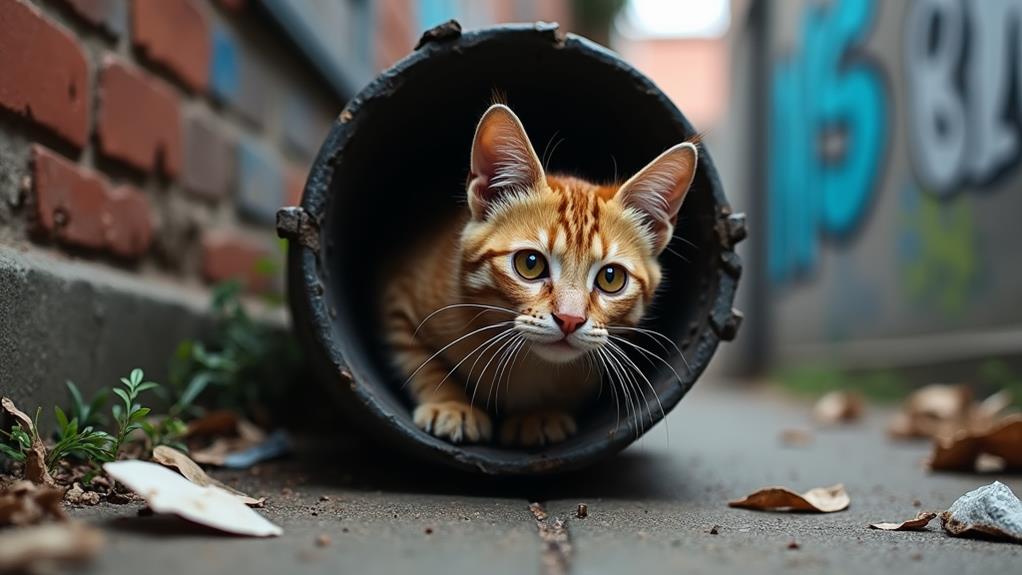
Community resources are vital when managing feral cat populations. Local animal control and welfare organizations are great starting points. They provide valuable assistance, offering trapping and management resources specifically designed for feral cats. Many communities have established TNR (Trap-Neuter-Return) programs. These programs are essential as they help stabilize feral cat populations in both a humane and effective manner. You should reach out to these programs, as participating in TNR initiatives can greatly impact your local feral cat community.
Veterinary clinics often play a supportive role by offering discounted services for feral cats. They encourage healthcare and population control through neutering, making it easier for you to manage these cats responsibly. Don't overlook the educational resources available through local shelters and organizations. They can help you understand the nuances of feral cat behavior and provide guidance on managing their presence in your neighborhood.
Collaboration with community initiatives can further promote the well-being of feral cats. Building shelters and creating safe spaces can reduce public concerns and improve the quality of life for these animals. By actively seeking out and utilizing these resources, you're taking significant steps to support and manage feral cat populations effectively.
Providing Appropriate Care
When caring for feral cats, implementing a TNR (Trap-Neuter-Return) program is fundamental. It's the cornerstone of providing appropriate care for these outdoor animals. By reducing the population growth humanely, you're guaranteeing a more stable and healthier colony. Alongside TNR, regular feeding and health monitoring are critical. Here's how you can guarantee feral cats receive the proper care they need:
- Set Up Feeding Stations: Install safe and discreet feeding stations that provide regular access to food and water. This reduces competition with wildlife and helps maintain their health.
- Collaborate with Local Organizations: Engage with animal welfare groups to access veterinary services, including vaccinations and medical care. Community support is imperative in managing feral cat health effectively.
- Provide Shelter: Construct or purchase weatherproof shelters to offer protection from harsh environmental conditions. This can greatly improve their well-being and reduce stress-related health issues.
- Observe and Respect: Understand the importance of leaving healthy feral cats in their environment. They're adapted to outdoor living and thrive best when managed with community support rather than individual intervention.


